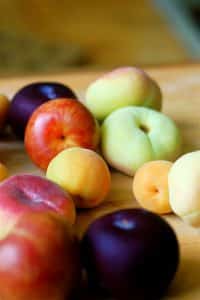Hi, everybody! Today we’re going to talk about stone fruits. They can be found in almost every local farmer’s market, grocery store or roadside stand. They’re in season from spring through early fall.
Stone fruits are a class of fruits called drupes. We talked about drupes when we discussed berries. Some berries are classified as drupes or stone fruits; although they don’t have stones in them. Stone fruits typically have thin skin, and all have a stone or pit in them. Can you believe olives and green almonds are considered stone fruits?
Stone Fruit Types
- Hybrids
Pluots, plumcots and apriums are a cross between plums and apricots. They differ based on the ratio of plum to apricot. Pluots are majority plum, plumcots are half plum/half apricot and apriums are more apricot than plum. They’re all perfect for baking and are available in late summer. - Cherries
Cherries appear in spring and vary in color from yellow to deep blackish-red. They range from tart to sweet. Get them at their peak in July and August. They’re fat-free and an excellent source of fiber, Vitamin C and potassium. Some studies show cherries might reduce the symptoms of gout and arthritis. - Peaches
One of the most popular stone fruits, peaches have a large pit and furry skin. They are either freestone or clingstone, come in white or yellow varieties and are about 70 calories each. Most of the calories come from carbohydrates. They’re an excellent source of vitamins A and C, potassium and fiber. The carotenoids in peaches are what give them their nice gold color and are 27 times more prevalent in the skin than flesh. Yellow peaches are great for cooking and baking.White peaches are lower in acidity and have a sweeter taste. They’re better for grilling and eating out of the hand. - Nectarines
Nectarines are like peaches but have smoother skin and are firmer than peaches. They also come in white and yellow and in freestone or clingstone varieties. Nectarines are great for grilling, baking and eating out of the hand. - Plums
There are about 20 types of plums and they vary in color from green, red, yellow and shades of dark purple. A regular-sized plum is about 60 calories. They’re fat-free and a significant source of fiber and vitamins A, C and K. They have either yellow or red flesh and typically taste tart before the sweetness comes. Plums also have a laxative effect in their dried form – prunes. - Apricots
Apricots resemble peaches and nectarines but are smaller. They’re tart with a rich texture. Eat them fresh or dried. Apricots — you either love or hate them. After the first taste, you’ll know whether you want to take another bite. Whether you like them or not, they’re nutritious – they’re fat-free and full of fiber, potassium and vitamins A, B and C. Two apricots are approximately 80 calories. - Mangoes
India is the largest producer of mangoes, with over 1,500 varieties. They have distinct tastes and colors. Despite not having a large pit, mangoes are a stone fruit. They’re a large fruit and are about 170 calories each. One mango provides over 90 percent of the daily requirement for vitamin C. They are also a substantial source of fiber and vitamins A, B and E. When ripe, mangoes have a sweet smell and are heavier than unripe ones.
Storing and Freezing
You should store stone fruits at room temperature until they are fully ripe. Once ripe, refrigerate, because they soften quickly. Peaches and nectarines take two to three days to ripen on the counter. Apricots ripen very quickly once they get soft.
The exception to this is cherries – they do not ripen once they’re picked. You should store fresh cherries in the refrigerator until you’re ready to eat them. Like most fruit, don’t wash them until you’re ready to eat them.
Before you freeze stone fruits – wash, cut in half, remove the pit and store in a freezer bag. Once defrosted, stone fruits are best used for baking because they’re mushy. You can dice defrosted peaches and use them to top your ice cream. You can cut frozen peaches in half, remove the pit, brush both sides with olive oil and grill them for about two minutes on each side until they soften. In Girl Scout camp years ago, we would wrap sliced peaches, butter, vanilla and sugar in foil packets then grill them. It was delicious!
Here are a few ideas to start your day with stone fruits:
- Add them to your cereal, pancakes, waffles or yogurt
- Make a smoothie
- Add thin slices of peach and mint to iced tea
- Use grilled stone fruits in salads, salsas, sauces and sangria
No matter how you decide to use stone fruits – enjoy!
Including fruits in your diet will help keep you healthy. Discover how our Flourish program can assist with your health and wellness journey.
View more of our nutritional news.

